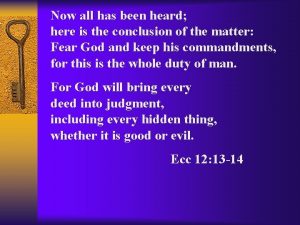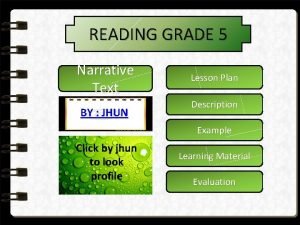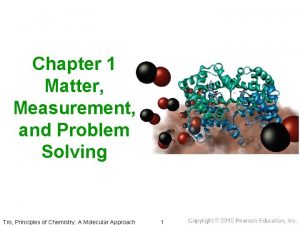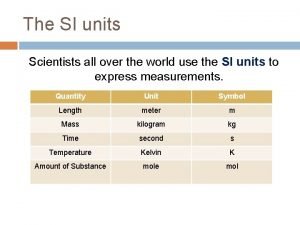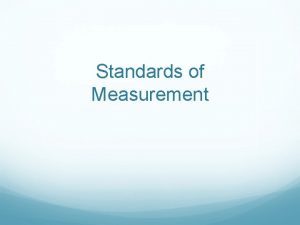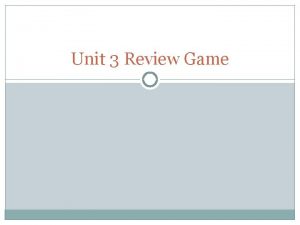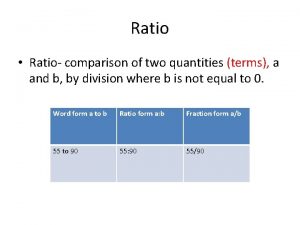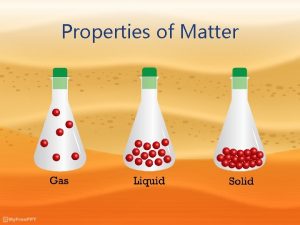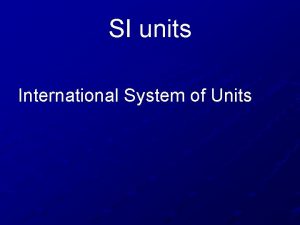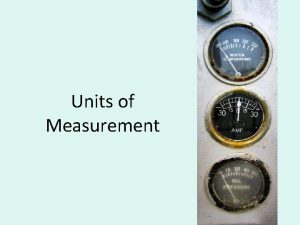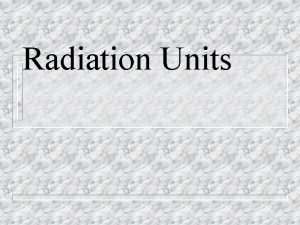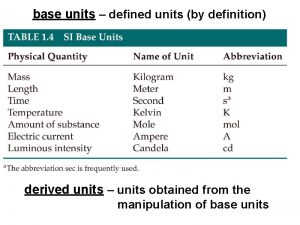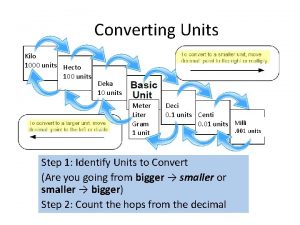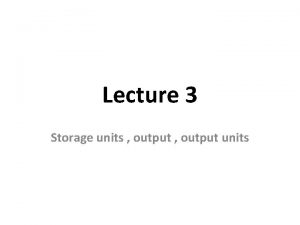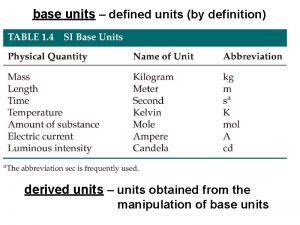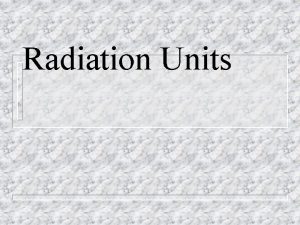Matter their SI units All matter has two












- Slides: 12

Matter & their SI units • All matter has two properties. • All matter has mass • • • All matter takes up space (has volume) • • The SI unit for mass is the kilogram (Kg) One Kg equals about 2. 2 lbs The SI unit for volume is the liter (L) One liter is a cubic decimeter. This rule will be bent later when talking about electrons (e-) Other SI units include sec, J, Hz.

Making Measurements • One must use units when making any measurement. • All measurements include one uncertain digit. – An uncertain digit is a guess and can vary from one person to another. – The uncertain digit is the last number recorded. It is a number that makes the measurement one number more accurate than the measuring device itself.

Making Measurements • All measurements have two kinds of numbers. – Those that are considered place holders & – Those that are considered significant

Significant Digits (figures) • Significant Digits are numbers use to write accurate measurements and to make accurate calculations. • Most Significant Digits are easy to identify. • All numbers from 1 -9 are always significant. • Zeroes are the real problem. There are rules. • Any zero between two significant digits is significant. • Any zero to the right of a decimal & to the right of a significant digit is significant. • Zeros as place holders are NEVER significant. • Examples: 8 80 808 8. 008 8. 080 800800 0. 0008 0. 008008000 876. 231 The more significant digits in a measurement, the more accurate the measurement.

Accuracy vs. Precision I • Accuracy is getting near the accepted value. • The more significant digits in a measurement, the more accurate the measurement is considered. • Precision is getting the same answer over and over. • Dart board analogy • Ultimately, scientists want to be both accurate and precise.

Accuracy vs. Precision II • When calculations are made, an answer can never be more accurate (meaning having more sig. figs) than the least accurate number. • Answers must be written to reflect this rule. • 203. 66 cm x 43 cm = 8757. 38 cm 2 • This answer must contain only 2 digits.

Accuracy vs. Precision III • 8757. 38 must be written using only two digits which is where powers of 10 aka scientific notation enters the picture. • Scientific notation is where the number is rewritten to be between 1 and 10 and be multiplied by 10 to some power. • Examples: a. 53 = 5. 3 x 101 b. 0. 0034 = 3. 4 x 10 -3 • Note that when the decimal moves left the power of ten increases by the number of place the decimal moves and • when the decimal moves right the power of ten decreases by the number of place the decimal moves

Powers of Ten Practice • 5. 6 x 100 =. 0032 = 5. 6 3. 2 x 10 -3 • 5. 6 x 103 = 5. 6 x 10 -2 = 5600 0. 056 • 8. 00 x 102 = 10 -2 = 800. 0. 01 • 76. 43 = 7. 643 x 101 or 7. 643 x 10 • So then 8757. 38 cm 2 would be written 8. 8 x 103 cm 2 • If the 43 were more accurate we would have more significant digits in the answer.

• How can I write 8757. 38 cm 2 to have only 2 digits – 1 – 2

Rounding 5’s I • Finally the last math in chemistry item. • This is one where chemistry and math do not agree. • What do we do when we have to round 5 ’s? • Math rounds 5’s up. They have a zero. • If you recall in slide #1, all matter must have mass and volume, therefore there is no such number as zero. Chemistry rounds 5’s to make the uncertain digit even. • Why?

Rounding 5’s II • If we have no zero in chemistry, then • 0, 1, 2, 3, 4, 5, 6, 7, 8, 9, 0 never really starts or stops. • If you round 5’s up you are always having error on the high side. Since there are just as many numbers below 5 as above 5 this is not very accurate.

Rounding 5’s III • Proof • Here is the problem: We want to round to nearest tenth. • 18. 65 + 19. 75 = • Calculator answer • 18. 65 + 19. 75 = 38. 40 = 38. 4 • Math way: Ø 18. 7 + 19. 8 = 38. 5 • Chemistry way: Ø 18. 6 + 19. 8 = 38. 4
 Now all has been heard here is the conclusion of the matter
Now all has been heard here is the conclusion of the matter Matter is anything that has mass and
Matter is anything that has mass and Matter anything that takes up space
Matter anything that takes up space Story the hungry mouse
Story the hungry mouse Opposite rays
Opposite rays Bocouture doses
Bocouture doses Absorption costing income statement
Absorption costing income statement Vector quantities measure
Vector quantities measure How do units matter in problem solving
How do units matter in problem solving Si prefix
Si prefix Si base units
Si base units A painter has exactly 32 units
A painter has exactly 32 units Comparison of 2 quantities
Comparison of 2 quantities
